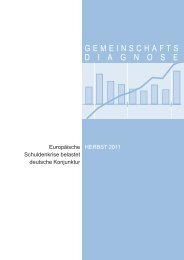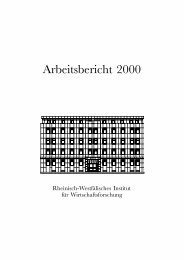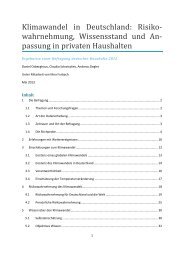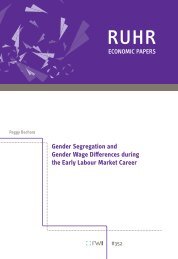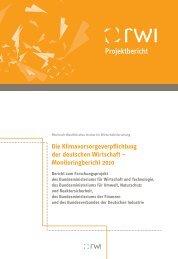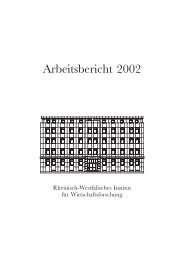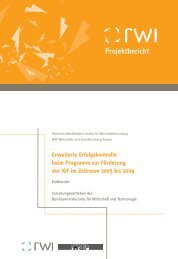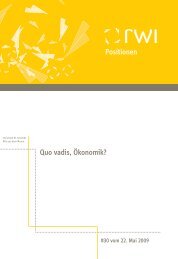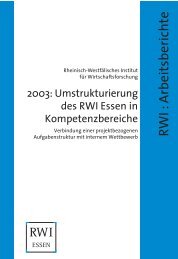RW I:Discussion Papers - Rheinisch-Westfälisches Institut für ...
RW I:Discussion Papers - Rheinisch-Westfälisches Institut für ...
RW I:Discussion Papers - Rheinisch-Westfälisches Institut für ...
You also want an ePaper? Increase the reach of your titles
YUMPU automatically turns print PDFs into web optimized ePapers that Google loves.
engaged in minor employment contracts. If agents react to wage rigidities by moving in<br />
or out of these types of employment, our measurement of the incidence of wage rigidities<br />
may be biased. Exclusion of minor employment furthermore truncates the earnings distribution<br />
covered by the data at the bottom. Besides, reported earnings are censored at<br />
the top. A peculiarity of the German Social Security scheme is that earnings are subject<br />
to contributions only up to a unitary threshold. For earnings exceeding the threshold,<br />
the IABS-R only reports the threshold value so that actual earnings are unknown. Since<br />
we cannot compute wage changes for censored earnings, we eliminate individuals with<br />
earnings observations at, or closely below, the threshold. While this approach is common<br />
practice, it is important to note that it changes the skill composition of the sample. Highskilled<br />
workers are removed more than proportionally. This might cause another selection<br />
bias in our rigidity measures, if wage rigidity is correlated with the skill (or wage) level.<br />
A major advantage of the IABS-R earnings data is their official status. There are<br />
legal sanctions for misreporting earnings and plausibility checks are performed by the Social<br />
Security authorities. Therefore the data are likely to be less affected by reporting<br />
or recording error than the survey data frequently used by empirical studies on nominal<br />
wage rigidity. Nevertheless problems of unobserved variability in wages arise which are<br />
not accounted for by our econometric model of measurement error. One problem is that<br />
only categorized information on working hours (full-time, part-time, less than part-time)<br />
is available. If hours worked by an individual change within a given category, the corresponding<br />
earnings change is not the same as the wage change conceptualized by our model.<br />
Since fluctuations in working hours tend to be more frequent among employees working<br />
less than full-time, we limit the sample to full-timers. This approach does not resolve,<br />
however, issues related to overtime. 7 Fringe benefits are another source of potential measurement<br />
error. One-time payments were not subject to Social Security contributions and<br />
therefore not systematically reported by employers prior to 1984. This causes a structural<br />
break in the wage change data at this date. More importantly, if one-time payments are<br />
more volatile than regular pay, it is possible that we overestimate wage rigidity at the<br />
beginning of the observation period.<br />
7 Overtime hours might be compensated with higher earnings or spare time. Accurate evaluation of wage<br />
changes not only requires information on overtime hours worked, but also on the relevant compensation<br />
scheme. Neither is available in our data. Moreover, related work for Germany indicates that the<br />
incidence of overtime work seems to be fairly stable, see Bauer and Zimmermann (1999).<br />
11



